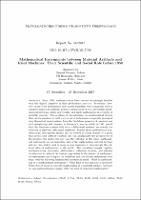| dc.date.accessioned | 2019-10-24T15:38:45Z | |
| dc.date.available | 2019-10-24T15:38:45Z | |
| dc.date.issued | 2017 | |
| dc.identifier.uri | http://publications.mfo.de/handle/mfo/3622 | |
| dc.description.abstract | Since 1950, mathematicians have become increasingly familiar with the digital computer in their professional practice. Previously, however, many other instruments, now mostly forgotten, were commonly used to compute numerical solutions, generate geometrical objects, investigate mathematical problems, derive new results, and apply mathematics in a variety of scientific contexts. The problem of characterizing the mathematical objects that can be constructed with a given set of instruments frequently prompted deep theoretical investigations, from the Euclidean geometry of constructions with straightedge and compass, to Shannon’s theorem which, in 1941, stated that the functions constructible with a differential analyzer are exactly the solutions of algebraic differential equations. Beyond these mathematical considerations, instruments should also be viewed as social objects of a given time period and cultural tradition that can amalgamate the perspectives of the inventor, the maker, the user, and the collector; in this sense, mathematical instruments are an important part of the mathematical cultural heritage and are thus widely used in many science museums to demonstrate the cultural value of mathematics to the public. This workshop brought together mathematicians, historians, philosophers, collection curators, and scholars of education to address the various approaches to the history of mathematical instruments and compare the definition and role of these instruments over time, with the following fundamental questions in mind – What is mathematical in a mathematical instrument? What kind of mathematics is involved? What does it mean to embody mathematics in a material artefact, and how do non-mathematicians engage with this kind of embodied mathematics? | |
| dc.title | Mathematical Instruments between Material Artifacts and Ideal Machines: Their Scientific and Social Role before 1950 | |
| dc.rights.license | Dieses Dokument darf im Rahmen von § 53 UrhG zum eigenen Gebrauch kostenfrei heruntergeladen, gelesen, gespeichert und ausgedruckt, aber nicht im Internet bereitgestellt oder an Außenstehende weitergegeben werden. | de |
| dc.rights.license | This document may be downloaded, read, stored and printed for your own use within the limits of § 53 UrhG but it may not be distributed via the internet or passed on to external parties. | en |
| dc.identifier.doi | 10.14760/OWR-2017-58 | |
| local.series.id | OWR-2017-58 | |
| local.subject.msc | 42 | |
| local.subject.msc | 01 | |
| local.subject.msc | 51 | |
| local.subject.msc | 37 | |
| local.subject.msc | 65 | |
| local.subject.msc | 78 | |
| local.subject.msc | 85 | |
| local.subject.msc | 97 | |
| local.subject.msc | 28 | |
| local.sortindex | 1062 | |
| local.date-range | 17 Dec - 23 Dec 2017 | |
| local.workshopcode | 1751 | |
| local.workshoptitle | Mathematical Instruments between Material Artifacts and Ideal Machines: Their Scientific and Social Role before 1950 | |
| local.organizers | Samuel Gessner, Lisboa; Ulf Hashagen, München; Jeanne Peiffer, Paris; Dominique Tournès, Sainte-Clotilde | |
| local.report-name | Workshop Report 2017,58 | |
| local.opc-photo-id | 1751 | |
| local.publishers-doi | 10.4171/OWR/2017/58 | |
| local.ems-reference | Gessner Samuel, Hashagen Ulf, Pfeiffer Jeanne, Tournès Dominique: Mathematical Instruments between Material Artifacts and Ideal Machines: Their Scientific and Social Role before 1950. Oberwolfach Rep. 14 (2017), 3471-3560. doi: 10.4171/OWR/2017/58 | |

